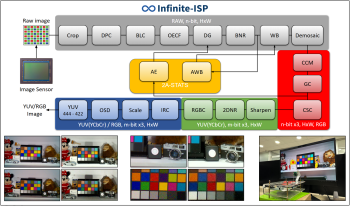
While traditionally not available in the public domain, access to the complete image signal processing (ISP) algorithmic pipeline and its hardware implementation are necessary to enable new imaging use cases and to improve the performance of high level deep learning vision networks. In this paper, we present Infinite-ISP: A complete hardware ISP development suite, comprising of an ISP algorithm development platform, a bit-accurate fixed-point reference model, an ISP register transfer level development platform, an FPGA development workflow and an ISP tuning tool. To aid the hardware development process, we develop end-to-end reference designs for the KV260 vision AI starter kit (AMD Xilinx Kria SOM) and Efinix Ti180J484 kit, with support for 3 image sensors (Sony IMX219, Onsemi AR1335 and Omnivision OV5647) using the Infinite-ISP framework. These ISP reference designs support 10-bit 2592×1536 4 Megapixel (MP) Bayer image sensors with a maximum pixel throughput of 125 MP/s or 30 frames per second. We demonstrate that the image quality of Infinite-ISP is comparable to commercial ISPs found in Skype Certified Cameras and also performs competitively with digital still cameras in terms of the perceptual IQ metrics BRISQUE, PIQE, and NIQE. We envision the Infinite-ISP (available at https: // github. com/ 10x-Engineers/Infinite-ISP ) under the permissive open-source license to streamline ISP development from algorithmic design to hardware implementation and to foster community building and further research around it for both academia and industry.

Optimizing exposure time for low light scenarios involves a trade-off between motion blur and signal to noise ratio. A method for defining the optimum exposure time for a given function has not been described in the literature. This paper presents the design of a simulation of motion blur and exposure time from the perspective of a real-world camera. The model incorporates characteristics of real-world cameras including the light level (quanta), shot noise and lens distortion. In our simulation, an image quality target chart called the Siemens Star chart will be used, and the simulation outputs a blurred image as if captured from a camera of set exposure and set movement speed. The resulting image is then processed in Imatest in which image quality readings will be extracted from the image and consequently the relationship between exposure time, motion blur and the image quality metrics can be evaluated.

Image signal processors (ISP) plays a significant role in camera systems by converting the RAW image from image sensor to a processed image. In order to achieve best image quality, the ISP parameters have to be configured in an iterative manner for various lighting conditions and scenarios, which is carried out by a camera tuning engineer. Usually, the manual tuning process takes up to several weeks to months due to huge number of ISP parameters to be optimized and the iterations involved to achieve good image quality. In this paper, we present a novel approach to automatically tune ISP parameters based on a multi-stage multi-criteria optimization approach using Non sorted Genetic algorithm (NSGA-II) for achieving objective and subjective image quality. In this approach, we focus on important blocks in ISP such as noise reduction, sharpness and tone mapping for human vision use-cases for camera systems widely used for smart phones or smart home IoT devices. The experiments for validating our approach are carried out under different scenarios using Qualcomm’s Spectra 380 ISP simulator and OV13880 sensor and the performance of automatic tuned IQ is compared with manual tuned IQ and some of the previous works done for automatically tuning ISP parameters. With the automatic ISP tuning approach, we verify the significant performance improvement in terms of IQ metrics and time consumed for the tuning process when compared to manual tuning approach.

Recently, with the release of 108 mega pixel resolution image sensor, the photo quality of smartphone camera, including detail, and texture, is getting much higher. This became possible only because by utilizing the remosaic technology which re-organize color filter arrays into the Bayer patterns compatible to existing Image Signal Processor (ISP) of commodity AP. However, the optimized parameter configurations of the remosaic block require lots of efforts and long tuning period in order to secure the desired image quality level and sensor characteristics. This paper proposes a deep neural network based camera auto-tuning system for the remosaic ISP block. Firstly, considering the learning phase, big image quality database is created in the random way using reference image and tuning register. Second, the virtual ISP model has been trained in order that predicts image quality by changing sensor tuning registers. Finally, the optimization layer generates the sensor remosaic parameters in order to achieve the user’s target image quality expectation. By experiment, the proposed system has been verified to secure the image quality at the level of professionally hand-tuned photography. Especially, the remosaic artifact of false color, color desaturation and line broken artifacts are improved significantly by more than 23%, 4%, and 12%, respectively.

In camera development, because the image quality is subjective and the tuning complexity is increasing, building a correlated model with image signal processor (ISP) pipeline is very demanding task. In order to overcome those problems, this paper proposes an automatic image quality tuning framework based on Deep Neural Network (DNN). The image quality metric (IQM) have been defined to quantifies subjective image quality, which effectively represents the actual user perception. In this way, fast reproduction of the desired image has been possible through the minimized computing resource. Proposed Optimization methodology consists of Phase 1, a ISP modeling, and Phase 2, parameter optimization. Phase 1 construct a model between the parameters of ISP and the image quality metric. At phase 2, we add partially connected layer at input layer in order to optimize the parameters of ISP. Using backpropagation approach, the network selectively updates only the weights of partial connections, which allow to automatically derive the optimal parameters for high quality image. This idea has been implemented and experimented through commercial 16 Mega pixel resolution CMOS image sensor (CIS) and the state-of-the art ISP.